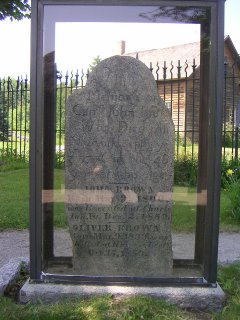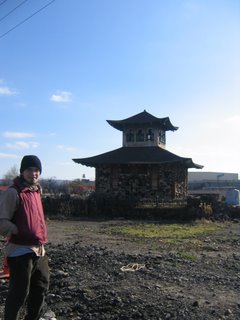Well, I was reading through the local "Greater Binghamton" paper, the Press and Sun Bulletin, today. For anyone who is not familiar with the Gannet publishing empire in Upstate New York, the Press and "Fun" is a pretty average local paper, which means it really doesn't cover any of substance when it can possibly avoid it, and when it does talk about things that actually affect our lives, it takes a hard Right-Wing approach where moderates are considered "liberals" and anyone left of George Pataki is something like a socialist. For instance, one day a year or two ago, I visited home and, like usual, I checked the news online when I woke up. It had been a busy night, with major suicide attacks in both Israel and Iraq, major political shake ups in important countries, etc etc. The Press and Fun's cover story was children eating ice cream at the park. Our nearest neighbor, Canada, just had a major political upset, with the ruling party loosing power in a no-confidence vote and was it even mentioned in the front pages? I'm afraid not.
What does this say about our communities when the newspapers, the supposed bulldogs of the democratic process are handmaids to the local officials and fill our minds with drivel? Why is the newspaper of Binghamton, a largely poor working class area, present a face that is only upper middle class? In my mind, the local papers are actually each tentacles of the massive Gannet monstrosity and are the source of many of the problems that face our communities. How can progress be made without debate or even a forum for debate? How can the voice of our community blithely pretend that life is good when a drive through downtown reveals their lie? Rupert Murdoch recently predicted the death of the American news paper, and while normally I disagree with everything he says, in this case I have to concur. But, its only because they are shooting themselves in the foot.
I will not, though, mourn the death of mediocrity and Gannet, because as real forums for discussion, they have been dead for years. I think there is some hope though, because when one door is shut and locked, often times people will find a window. One such opportunity in the Triple Cities near where I live is the Binghamton Indepdentent Media Center, a great organization that attempts to create a vibrant news alternative in my area. I've been thinking about volunteering, because they need to expand (especially of the net if possible, as we must remember that there is still a class barrier on the Internet) and be stronger.
I wasn't going to write about newspapers when I started this rant, my original goal was to talk about a story in the paper today regarding the County Executive's plan to keep young people in Broome County and about the absurdity and short-sightedness that fills her plan and every other one I've heard. Well, I guess that leaves something for tomorrow.
Posted by Jesse
11.30.2005
11.23.2005
The Burnt-Over District
 Recently, I have become interested in Spiritualism, a true American folk religion. While you may have never heard of its name, I'm sure everyone has heard of its classic manifestation: a seance conducted by a medium in a dark room where the spirits (hence the name) of the dead cross over and communicate to the living, both through the medium and through rappings, table-liftings, strange noises and apparent psychic phenomenon (like ESP and telekinesis). Spiritualism, over 150 years after its beginnings, is still going strong today, look at the Psychic Friends Network, Ramtha/JZ Knight (check here for the Wikipedia article), the television show Crossing Over (I think that was the name of it, it was featured quite prominently in South Park), countless books and television specials, but also in more grass-roots seances and popular belief in America.
Recently, I have become interested in Spiritualism, a true American folk religion. While you may have never heard of its name, I'm sure everyone has heard of its classic manifestation: a seance conducted by a medium in a dark room where the spirits (hence the name) of the dead cross over and communicate to the living, both through the medium and through rappings, table-liftings, strange noises and apparent psychic phenomenon (like ESP and telekinesis). Spiritualism, over 150 years after its beginnings, is still going strong today, look at the Psychic Friends Network, Ramtha/JZ Knight (check here for the Wikipedia article), the television show Crossing Over (I think that was the name of it, it was featured quite prominently in South Park), countless books and television specials, but also in more grass-roots seances and popular belief in America.What is particularly relevant to this blog though, is the little-known origins of American Spiritualism (there was a small movement in the late 1700's in Sweden, but modern Spiritualism comes from America). The first American mediums where three women called the Fox Sisters. The sisters lived in a supposedly haunted house in Hydesville, NY during the Antelbellum years with their parents where they learned to communicate with the ghost through a rapping code. The sisters quickly became national phenomenons, travelling and communicating with spirits. Soon everyone was getting in on the act and mediums were cropping up all over the place. Interestingly, while early Spiritualism was Christian in many aspects (1), it was in many ways a response to Christianity. Many early (and current, like JZ Knight) mediums were female and it existed as a faith system outside of the organized churches.
This rage in Spiritualism was not the only faith born out of Antelbellum Upstate NY. This area was known as the "Burnt-Over District," and experienced wave after wave of revivals, tent-meetings and spontaneous religious movements. It was home to not only the Fox Sisters but also to Joseph Smith, who founded Mormonism, William Miller and the Millerites, which is today called Seventh Day Aventism, the famous Oneida Community, and Charles Grandison Finney's early Pentacostalism. The area also was a haven for Shakers, the Fouiriest Utopians, the early Suffragettes (Seneca Falls) and Abolitionists like Frederick Douglass and John Brown (2). This was a time of powerful folk religion, some of which lives on among the Mormons in Utah (3) and in relics like the Cardiff Giant, displayed in the Farmer's Museum in Cooperstown.

What an incredible explosion of creativity in faith and social systems. I'm afraid I don't know enough about it to give an authoritative reason behind this time period, but I will venture a guess that it was related to: the frontier experience (Western NY was the frontier at that time) and its lack of organized religion, the fervour of the Second Great Awakening nationwide, the egalitarianism and belief in progress found in the early Republic and inherited religiousity from their Yankee New England roots.
The two photos I've added here are of John Brown's grave outside of Lake Placid in the Adirondacks and my buddy John being all holier-than-thou at the "Sacred Grove" where Mormonism-founded Joseph Smith supposedly saw God and Jesus who told him to found his own religion.
(1) It believed in the afterlife and heaven, a monotheistic God, angels/ghosts and a Christian values system.
(2) Most of this comes from a wonderful Wikipedia article. Also, technically, John Brown's farm is in the Adirondacks, not the Burnt-Over District, but it is Upstate New York.
(3) Like belief in modern prophecy, seeing stones and spiritual guides interacting in contemporary life.
Posted by Jesse
11.22.2005
Mazel Wok
Along Route 52 through the Catskills is the little village of Woodbourne in Sullivan County. I passed Mazel Wok two summers ago on my way back to Dutchess County from an archetypal time warp of Catskill vacationing, The Raleigh Hotel in South Fallsburg (a story, perhaps, for another post). I deeply regreted not having stopped and taken a picture of it. On my way to Johnson City this past weekend I was given a second chance.

At this time of year, Woodbourne is like a ghost town. But apparently, in summer, the town is hoppin' with Hasidim.
Posted by Natalie

At this time of year, Woodbourne is like a ghost town. But apparently, in summer, the town is hoppin' with Hasidim.
Posted by Natalie
11.21.2005
Adventures in Johnson City

One of the things that I love about this state is its sense of fading glory. You see, with fading glory, you don’t get any of the arrogance of new growth, or the growing pains. Don’t get me wrong, being a crumbling Rust Belt town comes with its own sorrows and pains, but it also seems to come with grim determination and stately resolve. And after all, who’s seen a building built in the last ten years that wasn’t as ugly as sin?
In our forests you find the remnants of old stone walls and farmer’s wells and in the brownfields and old neighborhoods of our cities are hidden little gems.
This last weekend, Natalie came up for a visit to my hometown of Johnson City and we took a tour of the crumbling industrial center of what used to be a company town. We stopped by all of the sites: the chrome 1950s diner, the beautiful wooden Ukrainian Orthodox Church, what used to be the world’s largest shoe factory and the nifty little county nature center where the staff does wonders with a shoestring budget and a couple dozen stuffed animals they got from the State Troopers cleanup of roadside accidents.
For me, though, the real highlight was a little building in the middle of a brownfield. Literally surrounded by the rubble of much grander factories survives the Pagoda. It kind of reminds me of the Once-ler’s house in The Lorax, you remember that strange little run-down building boxed in by leaning walls and overgrown grass?

The Pagoda was once the Pump House, some people say for the cooling machinery in the neighboring factory, others claim it pumped water for the nearby swimming pool constructed for workers and their families. Regardless, the Pagoda was built around 1925 by employees of the EJ Shoe company largely using garbage. The walls are made of broken bits of brick and pieces of metal. Broken gears, old knives and chains, bells and even a fire extinguisher were all incorporated into the walls of the Pagoda. I personally see it as a monument to the ingenuity and creativity of the EJ workers who constructed it. It has survived the destruction of all its neighbors simply because it is so charming and bizarre that even the normally inept and blind village government got its act together and protected it. I’ve even heard that there is a grant in the works to transport it across the street to CFJ Park (where the old pool was located) where it would be theoretically protected forever. The photos here are of me at the Pagoda, notice the gears and other things stuck into the walls.
And for those of you who haven’t read the Lorax lately do you remember:
“At the far end of town/
where the Grickle-grass grows/
and the wind smells slow-and-sour when it blows/
and no birds ever sing excepting old crows.../
is the Street of the Lifted Lorax/”
Posted by Jesse
Subscribe to:
Posts (Atom)
